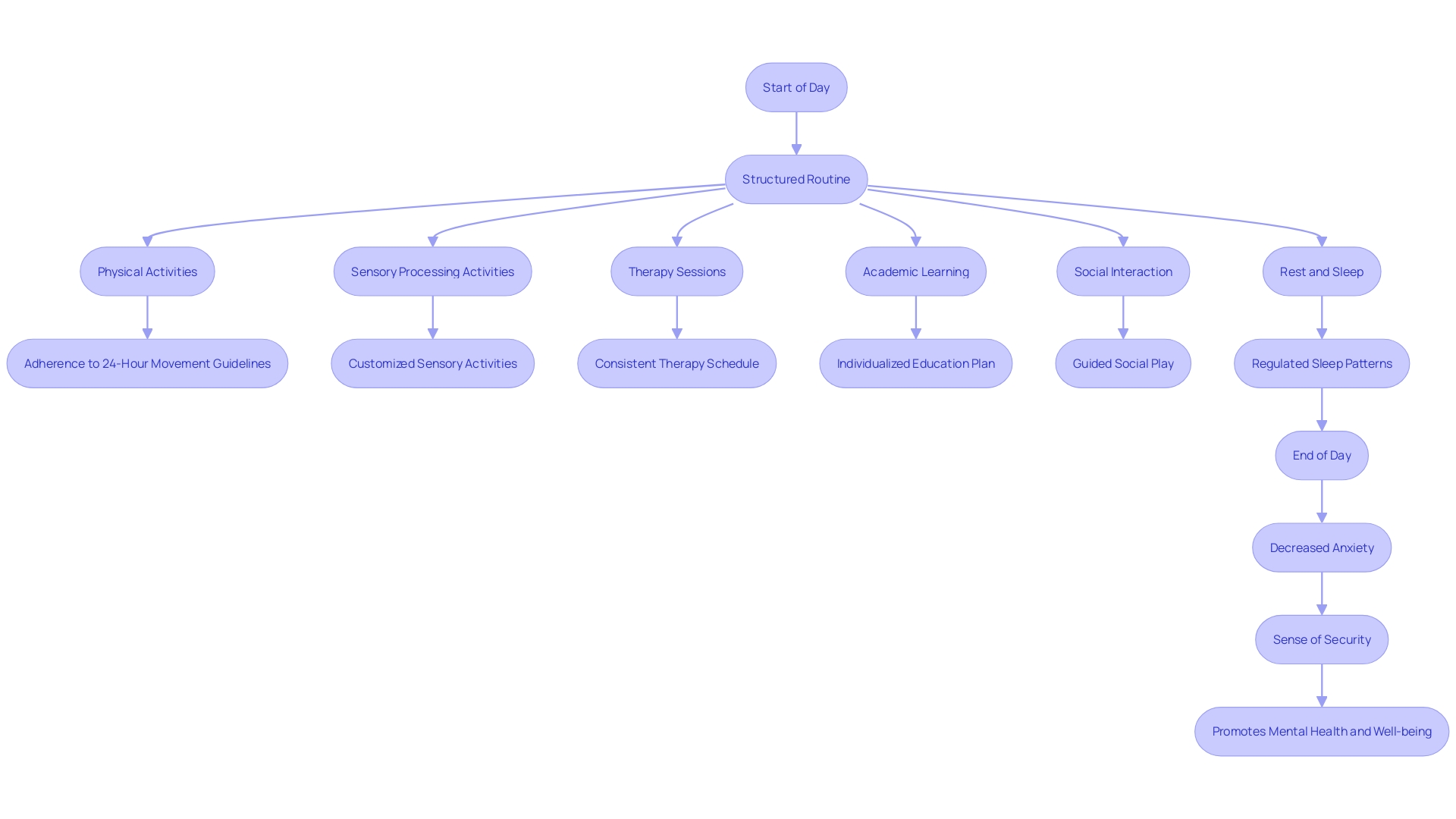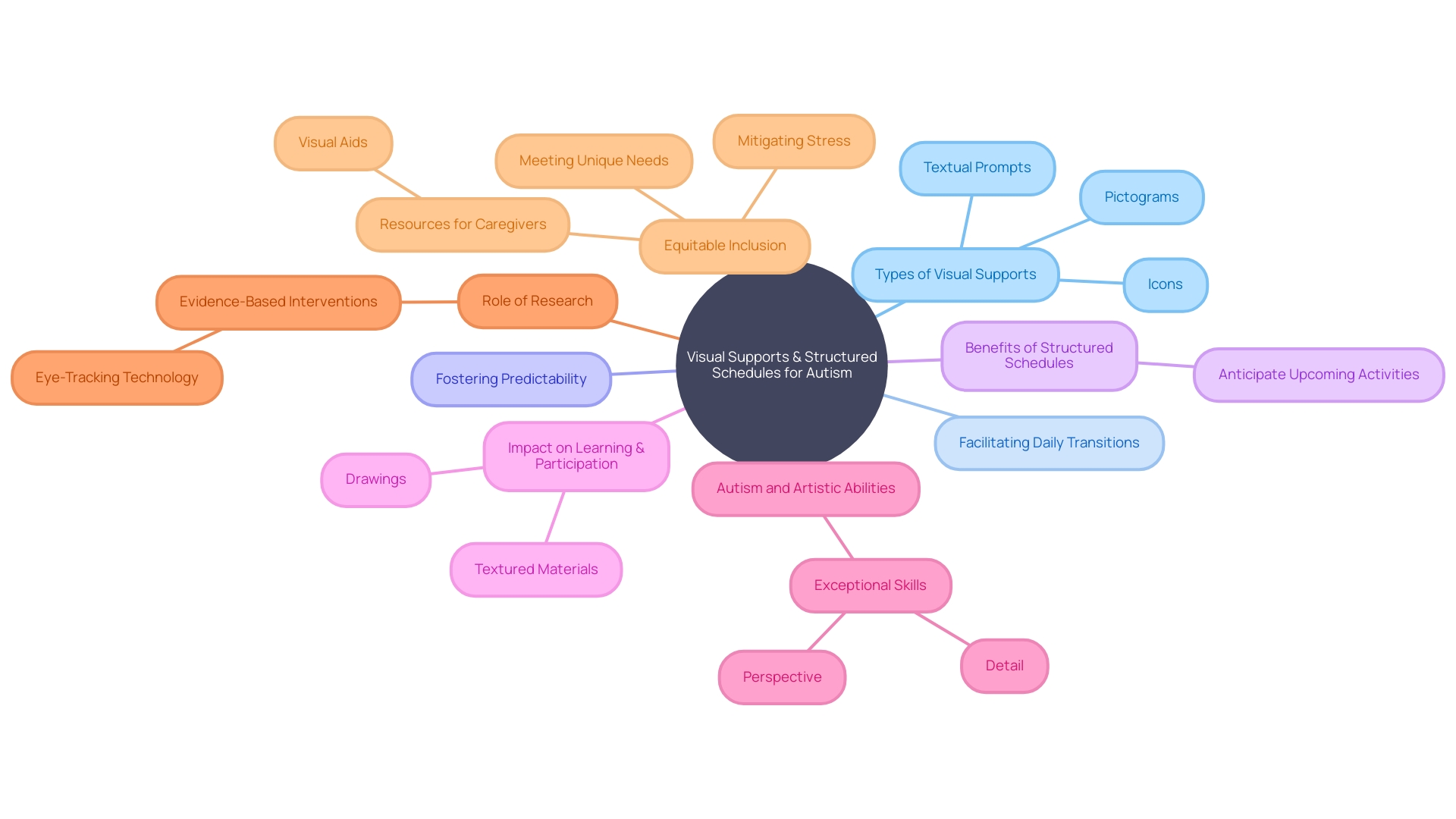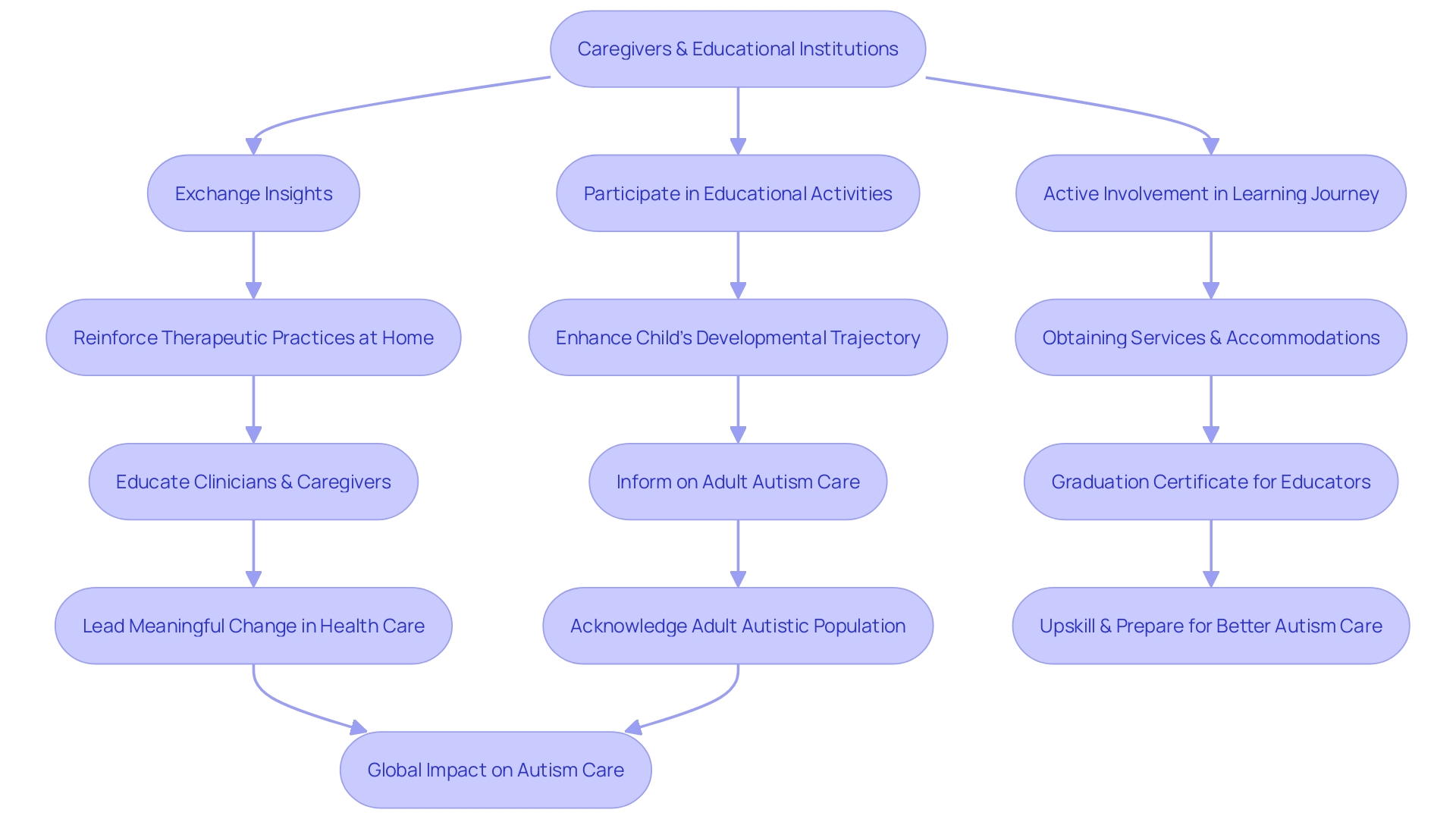Introduction
Autism spectrum disorder (ASD) is a complex condition that poses challenges in social interaction, communication abilities, and repetitive behaviors. Early recognition of ASD signs is crucial for ensuring timely interventions for children. Limited eye contact, delayed speech, repetitive movements, and difficulties with social engagement are some key indicators to watch for.
Recent studies highlight the importance of early detection and individualized intervention strategies. Technology advancements, such as eye movement analysis, are revolutionizing early diagnosis. As the prevalence of autism increases, it is vital for caregivers to stay informed about the latest research and treatment options.
Creating a consistent routine and structured environment is paramount to reduce anxiety and provide stability for children with autism. Visual aids and schedules are powerful tools that enhance comprehension and encourage self-reliance. Tailoring the child's surroundings to meet their sensory needs is essential for their mental health and engagement.
Strategies for enhancing social skills, effective communication techniques, positive reinforcement, and motivation all contribute to a child's development and well-being. Integrating home and school practices through collaboration between caregivers and educators creates a cohesive support system. Play-based intervention strategies harness the power of play to nurture vital skills in a natural and enjoyable context.
By embracing these approaches, caregivers can empower their children with autism to thrive and succeed in their unique journeys.
Recognizing Early Signs and Symptoms of Autism
Autism spectrum disorder (ASD) manifests early in life, often before a child reaches their third birthday. It is a complex condition marked by challenges in social interaction, communication abilities, and a tendency to engage in repetitive behaviors. Recognizing the early signs of ASD is critical for ensuring that children receive the interventions they need as soon as possible.
Signs to watch for include limited eye contact, delayed speech or absence of speech, repetitive movements, and difficulties with social engagement. Awareness of these early indicators is key, as it enables parents and caregivers to consult healthcare professionals and take proactive measures to nurture their child's growth.
For instance, a study in the Journal of Personalized Medicine highlighted the case of 4-year-old fraternal twin boys diagnosed with severe ASD at around 20 months. Their case underscores the importance of early detection and individualized intervention strategies. Furthermore, advances in technology are revolutionizing early autism diagnosis.
Groundbreaking research by Dr. Warren Jones and his team at the Marcus Autism Center has led to the development of 'the Marcus Test,' an automated tool that analyzes children's eye movements to predict autism diagnoses with astonishing accuracy.
In light of the ever-increasing prevalence of autism, it's imperative for caregivers to stay informed about the latest research and treatment options. As Beth Lambert from Epidemic Answers points out, not only is there hope for children with ASD, but there are also abundant resources to support them. It's essential for caregivers to understand the benefits and risks of any treatments or interventions and to observe their child's responses carefully.
By doing so, they can make informed decisions that best support their child's unique needs.
The Importance of Routine and Structure
Creating a consistent routine is crucial for children with autism, as predictability can considerably decrease anxiety and foster a sense of security. Structured schedules are not just about organizing daily activities such as meals or bedtime; they're about providing a reliable framework that integrates therapy sessions and other vital interventions. This consistency is paramount for autistic children who may struggle with transitions or unexpected changes.
By embedding these routines into everyday life, parents can offer children a stable platform from which to engage with the world. This approach aligns with the principle that establishing a fair and supportive environment is essential for children with disabilities to thrive. Such an environment acknowledges their needs, leverages their abilities, and ensures they are included in all aspects of life, thus promoting their mental health and well-being.
As research shifts toward more robust and reliable studies, such as randomized-controlled trials, the interventions within these routines can be fine-tuned, ensuring that each child receives the most effective support tailored to their unique challenges.

Using Visual Aids and Schedules
Visual supports and structured schedules serve as essential tools for children on the autism spectrum, facilitating daily transitions and fostering a sense of predictability. Such visual supports include an array of pictograms, icons, or textual prompts that represent various tasks or actions. Structured schedules, on the other hand, depict the order of events or actions within a given time frame, empowering children on the spectrum to foresee upcoming activities.
Employing these tools can significantly elevate a child's comprehension, encourage self-reliance, and alleviate stress.
For instance, consider the story of a six-year-old child with autism who initially engaged minimally in a classroom activity. With the introduction of visual elements such as paper drawings and textured materials, the child gradually became more involved in the task, highlighting the impact of visual stimuli on learning and participation.
Artists like Alex Schlueter, diagnosed with autism at the age of three, exemplify the profound capabilities that individuals on the spectrum possess, often exhibiting exceptional skills in areas like perspective and detail through visual art.
In the realm of autism research, studies underscore the importance of evidence-based interventions. For example, recent advancements in diagnostic technologies use eye-tracking to assess children's responses to social scenarios, offering insights into their engagement with visual information. This research not only enhances our understanding of autism but also reinforces the value of tailored visual aids.
Dr. David (Dan) R. Offord's sentiment, "I do not mind if my children are in a race as long as the race is fair," resonates deeply when considering the equitable inclusion of autistic children in society. This inclusion is facilitated when their unique needs are met, stress is mitigated, and caregivers are equipped with the necessary resources, such as knowledge and tools like visual aids, to support their children's developmental journey. It's a reminder that through informed approaches and supportive resources, children with autism can thrive in their environments, crafting a fairer race for all.

Creating a Safe and Supportive Environment
For children on the autism spectrum, their environment can significantly influence their mental health and their ability to engage in daily activities at school, at home, and during leisure time. To foster a sense of equity and ensure these children are not left behind, it's vital to tailor their surroundings to meet their unique sensory needs. This can be achieved by implementing thoughtful modifications that minimize sensory overload, such as establishing quiet zones for relaxation, reducing both visual and auditory stimuli, and incorporating sensory aids like weighted blankets and fidget devices.
The effectiveness of such environmental adjustments is evident in various case studies and real-world examples. For instance, a child with autism found it challenging to participate in a class project until the activity was adapted to his needs, demonstrating the power of a supportive setting. In another inspiring case, a young boy with a deep passion for airplanes was able to enjoy a rehearsal flying experience, where the familiar environment of an aircraft was recreated on the ground.
This allowed him to engage comfortably and confidently with his surroundings during an actual flight later on.
These personal stories are supported by Dr. Temple Grandin's expert advice on creating environments that consider the sensory sensitivities of autistic individuals, such as using non-flickering LED lights. Such attention to detail can transform a potentially stressful experience into an inspiring one, enabling children to react positively to their world.
By recognizing the assets that children with disabilities bring to their communities and reducing chronic stressors, caregivers can make a significant impact on their children's development and well-being. As we continue to discover new findings and approaches, it is crucial for parents and professionals to stay informed and discerning, ensuring that the environments we create for our children on the spectrum are not only safe but also nurturing and empowering.
Strategies for Enhancing Social Skills
Nurturing social skills in children with autism is vital for fostering their mental health and ensuring equitable opportunities for participation in various life domains. Dr. David Offord, a renowned child psychiatrist, emphasized the importance of creating a fair environment for all children, including those with disabilities, to thrive. This belief parallels the strategies employed by parents to enhance their child's social capabilities.
Social stories, personalized narratives that demystify social cues and appropriate responses, are a particularly effective tool. These stories equip children with autism to better perceive and engage in social exchanges. Similarly, role-playing exercises provide a secure space for children to rehearse and refine their social interactions, while peer modeling offers a chance to observe and emulate the social conduct of others.
Research underscores the significance of these strategies, highlighting that autistic individuals often process social information differently. By adopting methods like social stories, role-playing, and peer modeling, parents can directly impact their child's social learning and cognition, contributing to a more inclusive and supportive community.
Moreover, recent advancements, such as the development of objective biomarker-based tools, hold the promise of reducing healthcare disparities that currently hinder early autism diagnosis. Dr. Kristin Sohl from the University of Missouri School of Medicine emphasizes the urgency of this issue, especially for children of color, those in rural or underserved communities, and the crucial role that early identification plays in accessing effective treatments.
The potential benefits of such parental involvement and technological innovations are profound: they not only support the individual development of children with autism but also promote social justice by addressing the inequities in our healthcare system.
Effective Communication Techniques
Navigating the landscape of autism involves understanding the unique communication needs that come with it. For parents striving to enhance their child's ability to express themselves, embracing a variety of communication strategies is crucial. Visual supports can play a pivotal role in this process.
From communication boards to picture exchange systems, these tools offer concrete ways for children to connect with others. Simultaneously, clear and concise instructions paired with consistent visual cues can bolster the connection between verbal and nonverbal communication.
Recognizing the diversity of communication methods is essential, as sign language and assistive technologies provide valuable alternatives for children to articulate their thoughts and needs. The transformative impact of these technologies is not to be underestimated. As evidenced by the success stories of initiatives like the one led by the founder of Neurodiversity in Business, who witnessed his non-speaking son find a voice through picture boards, these tools can be life-altering.
Moreover, the commitment to improving communication for children with autism is underscored by research aimed at empowering not only the children but also the educators and family members who support them. With new grants focusing on training school-based SLPs to facilitate family implementation of communication strategies, there is a promising horizon for enhancing the support system around these children. Such advancements also carry the potential to address the stark disparities in autism diagnosis and intervention, particularly for children of color and those in underserved communities.
The journey of research and intervention in the realm of autism communication is ongoing, marked by a continuous evaluation of the effectiveness and safety of new approaches. As advocates for children with autism, it is incumbent upon us to stay informed about the latest developments and to discern the credible from the questionable. By doing so, we ensure that the interventions we support respect the fundamental dignity of each child and contribute to their growth and self-expression.
Positive Reinforcement and Motivation
Harnessing the power of positive reinforcement, parents can significantly influence the development and behavior of their children with autism. By celebrating successes and focusing on the strengths of their children, parents create an environment where children are more likely to engage in positive behaviors. Techniques such as offering praise, setting up reward systems, or using token economies can be tailored to each child's specific interests, ensuring the reinforcement is meaningful and effective.
The approach of 'catching them doing something right' not only builds self-esteem but also fosters a sense of achievement and motivation in children with autism. This strategy aligns with evidence-based practices such as the Interview Informed Synthesized Functional Analysis (IISCA), which aims to understand the function of behaviors and develop interventions that are responsive to individual needs, thereby promoting better outcomes in various settings, including home and educational environments. By leveraging these approaches, parents can nurture a positive atmosphere that supports their child's growth and progress.
Integrating Home and School Practices
Fostering a synergistic relationship between caregivers and educational institutions plays an integral role in nurturing children with autism, enabling them to thrive in various environments. By bridging the gap between home and school, parents can align strategies with educators and therapists, effectively creating a cohesive support system for their child. This collaborative effort might include exchanging insights, participating in educational activities, and being actively involved in shaping their child's learning journey.
Such involvement not only reinforces therapeutic practices at home but also contributes to a seamless transition between therapy and daily life, thereby enhancing the child's developmental trajectory.
- "Life is 10% what happens to us and 90% how we react to it." - Dennis Kimbro
This quote underscores the importance of a proactive and positive approach to the unique challenges faced by children with autism. By adopting this mindset, parents can become the catalysts for their child's progress. The compelling narrative of Lil's transition to a new educational setting in the UK illustrates the significance of preparation and adaptability during periods of change.
Similarly, the insights from Dr. Offord emphasize the equitable participation of children with disabilities in all life domains as essential for their mental health and the well-being of their families. To address the long waiting periods for autism assessment and support, as highlighted in the report by Child of the North and the Center for Young Lives, a 'needs-led' approach is advocated, emphasizing early identification and prompt, effective support that doesn't solely hinge on a formal diagnosis. This strategy is imperative for mitigating risks such as mental health issues and educational disengagement, ensuring that every child has a fair start in the race of life.

Play-Based Intervention Strategies
Recognizing the critical role of play in the cognitive, social, and emotional development of children with autism, it's essential to highlight the value of play-based intervention strategies. These strategies harness the power of play to nurture vital skills in a natural and enjoyable context. By aligning activities with the child's unique interests and preferences, parents can effectively support their child's growth in areas such as social interaction, imaginative play, and cooperative behaviors like turn-taking.
Such personalized, engaging approaches not only foster a child's development but also contribute to their mental health and well-being, ensuring they participate actively and confidently in their everyday environments. Recent shifts in autism research towards randomized-controlled trials underline the commitment to providing evidence-based practices, emphasizing interventions that result in meaningful, sustainable progress. Celebrating each child's achievements, whether through a shared joke or a novel play idea, brings immeasurable joy and is a testament to the success of tailored interventions.
It is through these moments that children truly shine, demonstrating the profound impact of integrating play into therapeutic practices.
Conclusion
In conclusion, early recognition of the signs and symptoms of autism spectrum disorder (ASD) is crucial for ensuring timely interventions for children. Limited eye contact, delayed speech, repetitive movements, and difficulties with social engagement are key indicators to watch for. Recent advancements in technology, such as eye movement analysis, are revolutionizing early diagnosis, highlighting the importance of staying informed about the latest research and treatment options.
Creating a consistent routine and structured environment is paramount to reduce anxiety and provide stability for children with autism. Visual aids and schedules are powerful tools that enhance comprehension and encourage self-reliance. Tailoring the child's surroundings to meet their sensory needs is essential for their mental health and engagement.
Strategies for enhancing social skills, effective communication techniques, positive reinforcement, and motivation all contribute to a child's development and well-being. Integrating home and school practices through collaboration between caregivers and educators creates a cohesive support system. Play-based intervention strategies harness the power of play to nurture vital skills in a natural and enjoyable context.
By embracing these approaches, caregivers can empower their children with autism to thrive and succeed in their unique journeys. It is important for Parent Advocates to stay informed about the latest resources and guidance to navigate challenges and ensure the well-being of their children with autism. Together, we can create a supportive and empowering environment that allows every child to reach their full potential.




